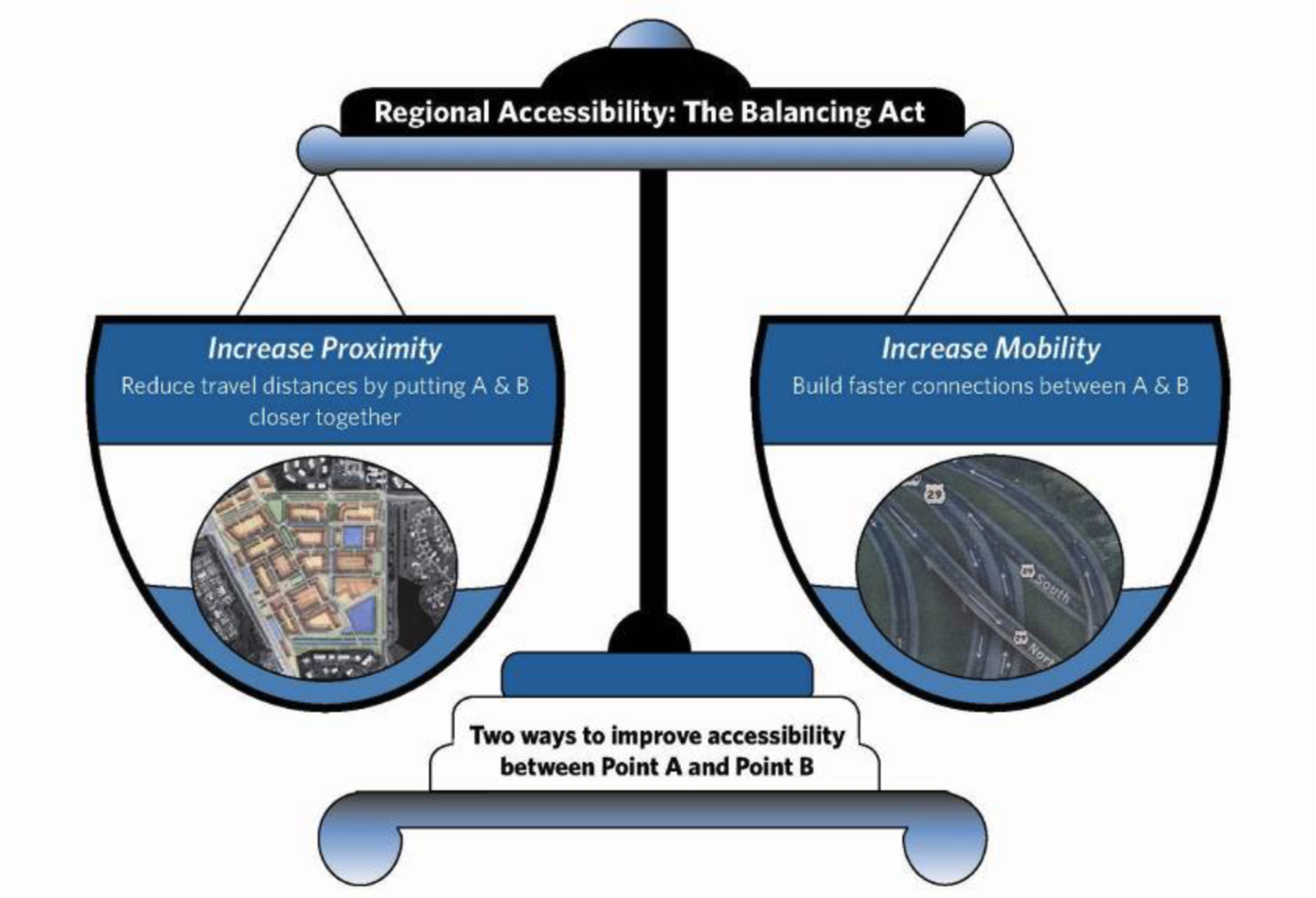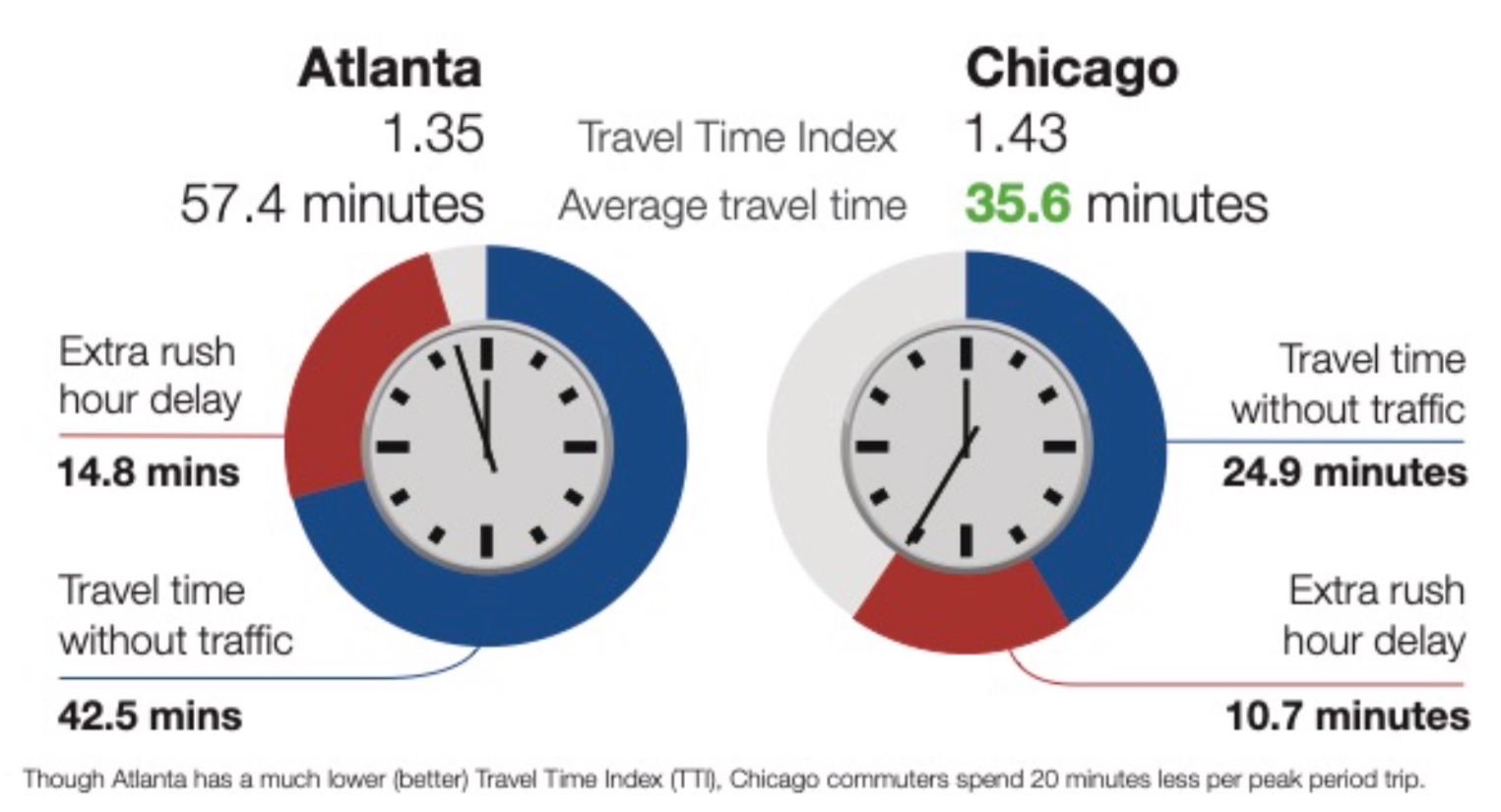Quick Read
MARTA is a radial grid that focuses all of its movement to an empty downtown and lacks the vital circle lines that allow people to get to the activity centers spread around the city. To the vast majority of City of Atlanta residents, MARTA is only useful if you work downtown and the occasional event or jury summons. With More MARTA’s current prioritization, MARTA will continue to offer no relief to Atlanta’s overloaded roads as the city’s population grows by 140% in the next 20 years.
Magic Wand?
David Wickert, a reporter at the AJC, recently posted a question You have a magic wand: How would you solve Atlanta’s traffic mess? By traffic, I assume he means, congestion, which by itself is not a problem. Congestion is actually a sign of a strong economy. However, Atlanta does have a problem with long trip times which are a sign of sprawl aided by the overbuilding of roads for personal cars. Atlanta is simply too spread out.
This idea was laid out succinctly to multiple Atlanta transportation officials and politicians at Transportation for America’s Capital Ideas Conference in December. Nick Donohue, Deputy Secretary of Transportation, Commonwealth of Virginia presented the balancing act needed to achieve regional accessibility. He explained how the city of Atlanta and the state of Georgia have been consistently selected to “Increase Mobility” over “Increasing Proximity”. Resulting in commute times far longer than other cities and Atlanta being the example of what not to do.
Atlanta hasn’t always been the butt of transportation jokes. Unfortunately, the Atlanta residents that lived in our city when we had a dense community and a public transportation that made Europeans envious are long gone. Luckily the City of Atlanta Planning department has laid out our path forward for a dense community. So Atlanta only needs a refresher on how an ideal public transportation system should operate. The following comes from The Basics by Jarrett Walker, one of the country’s most influential thinkers on transit.
The Basics
The Ideal Transit System
The ideal transit system does not give preferential treatment to any point in the city. It allows its passengers to travel from anywhere to anywhere else by a reasonably direct path and at high frequency. This system is a rectangular grid with parallel lines, each far enough apart that everyone can walk to one of them, and another set of the same lines perpendicular to them. In this system, everyone is within walking distance of one north-south line and one east-west line. So, they can get from anywhere to anywhere, with one connection, while following a reasonably direct L-shaped path.
Radial Transit System
Atlanta’s MARTA is not set up as a rectangular grid, but as a radial grid with its center in downtown. Normally, this radial grid can work just as well as a rectangular grid. A passenger should be able to make a reasonably direct trip between non-downtown points by using one of the circle lines in combination with one of the radial lines. Unfortunately for Atlanta residents, MARTA is not a typical radial grid.
First, the radial grid is only efficient if the downtown is so dominant that it can justify the huge amount of service converging there. Atlanta is the opposite of having a dominant downtown. It is a city of neighborhoods with activity centers all over the city with relatively little to do downtown. As a result, very few City of Atlanta residents ever go downtown and even less actually live there.
Second, MARTA’s bus routes move along radial lines within four quadrants. None of these bus routes pass between quadrants which makes a radial grid without any circle lines! Without circle lines, Atlantans cannot make reasonably direct trips between non-downtown points. This is particularly evident for residents in the southern quadrants that lack the quantity of jobs, education, healthcare, parks, recreation, groceries, arts, restaurants, and stores that the northern quadrants offer. Southern residents have to pay a transfer penalty to visit the northern quadrants. A transfer penalty is the real and measured cost of the uncertainty in making connections when we are forced to change buses.
How did we get here and where are we going?
In 1971, MARTA was built to move tourists and regional commuters to the center of the city. It has been underfunded since its inception and the State of Georgia has yet to make any contribution, making MARTA the only major mass transit system in the country that does not receive state support.
Today, the City of Atlanta is projected to grow from a population of 486,000 to 1.2 million by 2040. Atlanta’s planning department created an aspirational city design aimed at evenly distributing this growth around the city. Specifically encouraging growth in the long neglected southern side of the city.
Encouraging most growth in the Atlanta’s south
Atlantans have already begun to pour in to the southern neighborhoods and our roads are full. We are desperate to spend less time in our cars but still need to get to the jobs, education, healthcare, parks, recreation, groceries, arts, restaurants, and stores we need all around the city. In 2016, Atlanta residents voted to tax ourselves $2.5B to change MARTA to better serve our needs. For this $2.5B, MARTA has selected the following projects from the $11B list of projects used to get Atlantans out to vote.
MARTA’s bus routes with the new More MARTA routes
With this investment in rail around the BeltLine, MARTA seemed to start to understand that Atlanta residents have other places to go that are not in downtown. Unfortunately, MARTA’s draft project timeline opposes the view that MARTA is getting ‘smarta’.
More MARTA Schedule
MARTA has prioritized installing light rail on radial lines that have existing bus routes and postponed the desperately needed BeltLine circle past 2045.
MARTA is a radial grid that focuses all of its movement to an empty downtown and lacks the vital circle lines that allow people to get to the activity centers spread around the city. To the vast majority of City of Atlanta residents, MARTA is only useful if you work downtown and the occasional event or jury summons. With this prioritization, MARTA will continue to offer no relief to Atlanta’s overloaded roads as the city’s population grows by 140% in the next 20 years.
Short Term Change
MARTA should align its priority to “completing the radial grid”. Simply we need transit circles aligning with the density our city is planning. MARTA can prioritize rail on the entire BeltLine by 2030 and using the $210M allotted for “Bus Service Improvements” to create the three additional circle lines pictured below. Additionally, bus routes like Boulevard, Moreland, North Ave and others need to continue their routes without forcing a change at the border of a quadrant.
Aligning Transit with Density
Long Term Change
City of Atlanta residents are arguing for prioritizing the best use of $2.5B because we find the current system mostly useless. The BeltLine loop would get many of us to the jobs, education, healthcare, parks, recreation, groceries, arts, restaurants, and stores we need in our daily life. The truth is all of the projects on the $11B project list and more are needed. Having effective public transportation dramatically affects our air quality, our affordable housing, and our quality of life. Atlanta is in a transportation crisis and it is going to get a lot worse. Atlanta needs serious investment in its public transportation system now. Mayor Bottoms and Governor Kemp must make this a priority or the people and businesses that make up this city will decide to leave.









